Growing Iceberg Lettuce Indoors: A Comprehensive Guide
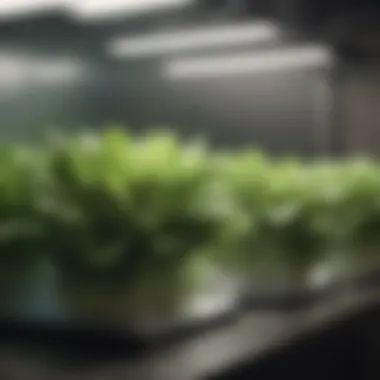
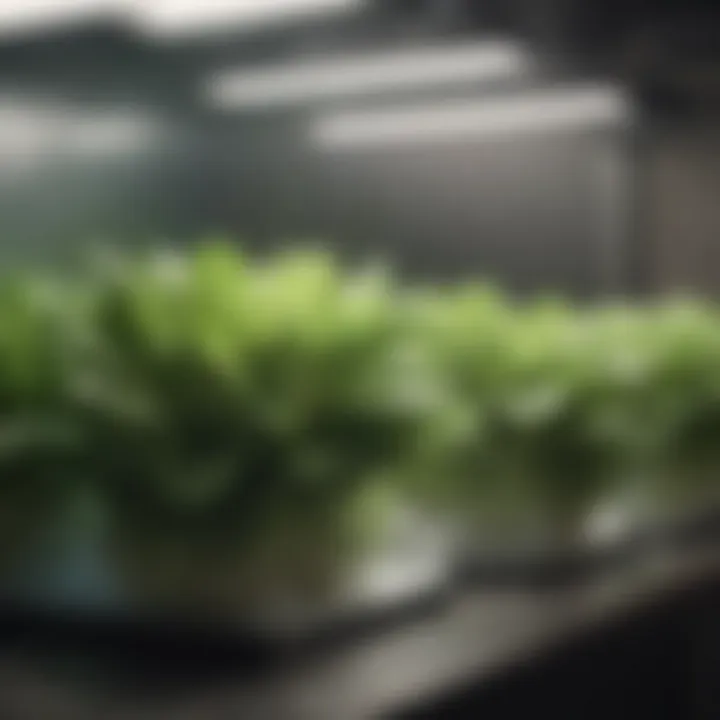
Intro
Growing iceberg lettuce indoors has gained popularity among gardeners as a viable way to obtain fresh produce year-round. This engaging approach satisfies the need for sustainable living, even in limited spaces. For homeowners, indoor cultivation enables easy access to crisp greens, while decorating the home with vibrant vegetation.
The indoor environment poses certain challenges, but the rewards of cultivating hose leafy vegetables exceed these hurdles with the right knowledge. Let's explore methods of successfully growing iceberg lettuce indoors and the significance of ornamental gardening in residential spaces.
Prelude to Indoor Gardening
Indoor gardening has gained increased attention in recent years, particularly as more people seek sustainable methods of food production within their homes. Growing iceber lettice indoors exemplifies the shift towards accessible, small-scale agriculture that aligns with modern lifestyles. This article emphasizes the significance of indoor gardening, not merely as a hobby, but as a vital approach to fostering self-sufficiency and enhancing well-being.
Importance of Indoor Gardening
The importance of indoor gardening extends beyond the mere act of planting seeds in pots. It reflects an evolving relationship with food and the environment. As urban spaces grow denser and outdoor gardening opportunities diminish, indoor gardening offers individuals a chance to cultivate their own produce irrespective of spatial limitations.
Moreover, indoor gardening promotes an awareness of health and sustainability. By growing your own food, you can control the quality and avoid pesticides or harmful chemicals commonly found in commercially produced crops. This not only ensures healthier options for consumption but also allows gardeners to experiment with varieties that may not be available at local stores.
Indoor gardening also encourages mindfulness. Engaging with plants serves as a form of therapy. It fosters a sense of responsibility and accomplishment when seedlings flourish into mature greens.
Benefits of Growing Iceberg Lettuce Indoors
Growing iceberg lettuce indoors yields several distinct benefits. First, being a fast-growing leafy green, this lettuce type provides rapid harvests, enabling gardeners to enjoy fresh produce within weeks of planting. The convenience of having salad greens available at home can significantly enhance meal preparation without reliance on store-bought options.
Second, iceberg lettuce thrives under controlled conditions. This adaptability makes it an excellent choice for novice gardeners or those with limited experience. The requirement for moderate light and consistent moisture aligns well with common home environments.
Additionally, cultivating iceberg lettuce indoors can contribute to reducing carbon footprints. By producing food within domestic spaces, reliance on transportation and packaging, which often add to environmental impacts, can be minimized. The practice supports local consumption and encourages the use of organic growing practices.
In essence, indoor gardening, particularly the cultivation of iceberg lettuce, encapsulates an engaging blend of satisfaction, sustainability, and health benefits in a practical setting.
Understanding Iceberg Lettuce
Understanding iceberg lettuce is crucial for ensuring a successful indoor gardening experience. This leafy vegetable is often chosen for its crisp texture and mild flavor, making it popular in various dishes. It features a dense head and pale green leaves that can thrive indoors with proper care and knowledge. Familiarizing oneself with its characteristics and nutritional value can significantly enhance the quality of the harvest and overall growing experience.
Characteristics of Iceberg Lettuce
Iceberg lettuce (Lactuca sativa) is one of the most recognizable varieties of lettuce. It has distinct physical traits, including its tightly packed head and crunchy leaves. The leaves are generally light green and may appear almost white towards the center. This variety tends to grow in a compact structure, allowing it to fit in smaller indoor spaces.
Additionally, iceberg lettuce has specific growth habits. It typically requires full sunlight or bright indirect light for optimal growth. The plant can reach a height of 6 to 12 inches and will form a rounded head as it matures.
Characteristics to note:
- Growth Time: Iceberg lettuce usually takes about 70 to 80 days from seed to harvest.
- Environment: Prefers cooler temperatures (60-70°F) and thrives in well-draining soil.
- Water Needs: Regular watering is necessary but should be controlled to prevent overwatering.
Nutritional Value of Iceberg Lettuce
The nutritional profile of iceberg lettuce is often overshadowed by other leafy greens, yet it offers several health benefits. While it is low in calories, it is a source of essential nutrients. A single cup of shredded iceberg lettuce contains approximately:
- Calories: 10
- Vitamin A: Contributes to eye health.
- Vitamin K: Important for bone health and wound healing.
- Folate: Plays a role in cellular function and tissue growth.
- Water Content: Over 90% water, which aids hydration.
In summary, iceberg lettuce provides a refreshing addition to a balanced diet. It offers hydration and is a low-calorie food, making it suitable for various meal plans. Understanding its characteristics and nutritional benefits prepares you to grow it more effectively in an indoor setting.
Remember: The right care and knowledge about iceberg lettuce are key to enjoying both its beauty and health benefits in your home.
Choosing the Right Indoor Space
Selecting the appropriate indoor space for growing iceberg lettuce is essential for successful cultivation. A conducive environment allows for optimal growth, which leads to healthier and more productive plants. Understanding the specific requirements of iceberg lettuce helps ensure that you provide the right conditions. This article will delve into two critical elements: light requirements, and temperature and humidity control.
Light Requirements
Iceberg lettuce thrives in bright, indirect light. Therefore, the location of your plants matters a lot. Ideally, place your lettuce near a south-facing window that gets at least 12 to 14 hours of light daily. Issues may arise if the light is insufficient, such as spindly growth and a lack of flavor. If natural light is limited, consider using grow lights. Full-spectrum LED lights are very effective for indoor gardening, providing the right spectrum for photosynthesis. Set the grow lights about 6 to 12 inches above the plants and maintain a consistent light schedule.
- Types of Grow Lights:
- LED grow lights
- Fluorescent lights
- High-Intensity Discharge lights
Observe your lettuce closely. If you notice yellowing leaves, it can indicate too little light or possibly other issues.
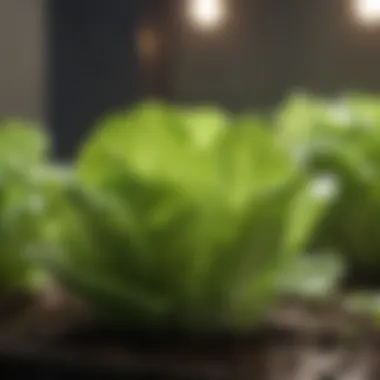

Temperature and Humidity Control
Iceberg lettuce prefers cooler growing conditions, typically between 60°F to 65°F (15°C to 18°C). Temperatures above 70°F (21°C) can cause the plants to bolt, leading to flowering and a bitter taste. Maintaining a stable environment can be tricky indoors, but it is crucial.
Consider using a small fan to circulate air around your plants if the space is small or poorly ventilated. This can help prevent diseases caused by high humidity. Additionally, monitor humidity levels. Ideal indoor humidity for lettuce ranges from 50% to 70%. If it is too low, consider using a humidifier or placing a water tray nearby to increase moisture in the air.
Maintaining the right temperature and humidity levels is key to healthy iceberg lettuce production.
In summary, choosing the right indoor space for your iceberg lettuce cultivation necessitates careful consideration of light, temperature, and humidity. By prioritizing these elements, you can succeed in growing delicious, crisp lettuce indoors.
Necessary Tools and Equipment
When embarking on the journey of growing iceberg lettuce indoors, selecting the right tools and equipment is paramount. The tools you choose will significantly impact your gardening success. This section will detail the essential items that every indoor gardener should consider. Proper equipment lays the foundation for healthy, productive plants.
Containers and Potting Soil
Choosing the right container is critical for the growth of iceberg lettuce. Containers should provide adequate drainage, prevent overwatering, and be large enough to allow root development. Look for pots with multiple drainage holes at the bottom. Size matters; typically, a container with a depth of at least six inches works best.
The type of potting soil you use also plays a crucial role. A well-aerated soil mix promotes root health and growth. Look for a potting mix designed for vegetables, which usually combines peat moss, vermiculite, and perlite. This mixture provides nutrients while maintaining adequate moisture without becoming overly compacted. Organic options are recommended as they improve nutrient availability and soil structure over time.
Lighting Options
Light is essential for indoor growing, especially for iceberg lettuce, which requires ample illumination to thrive. Natural light can be insufficient, particularly in winter months or in rooms with limited windows. Therefore, lighting options are an area to consider seriously.
LED grow lights are increasingly popular. They consume less energy and last longer than traditional grow lights. Choose a full-spectrum LED light to ensure your lettuce receives the optimal wavelength for growth. Lights should be positioned approximately 6-12 inches above the lettuce plants. Adjust the height as necessary as the plants grow. A timer is also recommended to maintain a consistent light cycle, typically 12-16 hours per day.
Watering Tools
Efficient watering is critical in growing iceberg lettuce indoors. Overwatering can lead to root rot, while under-watering can hinder plant development. Use a watering can with a long spout for better control, allowing you to direct water precisely to the base of the plants.
A moisture meter can be an invaluable tool. This device helps determine the water level in the soil, preventing guesswork. Check the moisture regularly, ensuring the top inch of soil maintains a consistent level of dampness. Consider using self-watering pots as an alternative, which help regulate water supply, thus reducing the risk of overwatering.
"Using the right tools not only simplifies the growing process but also enhances the quality of your crop."
In summary, proper tools and equipment contribute significantly to the success of growing iceberg lettuce indoors. Select containers that offer good drainage, utilize the right potting soil, ensure adequate lighting, and implement effective watering methods. By preparing adequately, you create a conducive environment for your plants to flourish.
Planting Iceberg Lettuce Seeds
Planting iceberg lettuce seeds is an essential step in the process of cultivating this fibrous vegetable indoors. This section will detail the significance of seed selection and the proper techniques for planting, which are crucial for ensuring a successful harvest. Choosing the right seeds is not just about preference; it affects growth rates, resilience to pests, and overall yield.
Seed Selection
The selection of seeds for iceberg lettuce plays a pivotal role in achieving healthy plants. Consider several factors when selecting your seeds:
- Variety: Choose from reputable varieties known for indoor growth such as Butterhead or Crisphead. Look for seeds that are marked as suitable for indoor cultivation.
- Germination Rate: Check the packaging for information about the germination rate. A higher germination rate indicates a better chance of producing healthy seedlings.
- Seed Quality: Quality seeds will have a more uniform shape and color. Avoid seeds that are discolored, uneven, or contain debris. Quality directly influences the growth vigor of your plants.
- Source: Purchase from established distributors like Burpee or Johnny's Selected Seeds. This reduces the risk of contamination and increases the likelihood of obtaining viable seeds.
Choosing the right seeds will set the stage for successful growth and ultimately improve your indoor gardening experience.
Planting Techniques
Once the seeds are selected, the next phase is planting, and this involves several key techniques:
- Soil Preparation: Use a well-draining potting mix. It should have a pH that ranges from 6.0 to 7.0. Consider adding perlite to the soil for improved aeration and drainage.
- Container Selection: Employ containers that have drainage holes. This prevents waterlogging, which can harm the seeds. A shallow container with at least 6 inches of depth works well.
- Planting Depth: Seeds should be planted at a depth of 1/4 to 1/2 inch. Spacing seeds with about 1 inch apart allows room for the seedlings to develop without competing for nutrients.
- Moisture Control: After planting, gently water the soil using a spray bottle to avoid disturbing the seeds. Maintain consistent moisture, but avoid oversaturating the soil.
- Temperature Conditions: Aim to keep the soil temperature between 65°F and 75°F for optimal germination. A seedling heat mat can help if the surrounding environment is cooler.
By adhering to these techniques, the chances of germination increase, and seedlings are more likely to thrive once they emerge.
Remember, patience is key. Lettuce seeds typically germinate within 7 to 14 days, depending on the environmental conditions.
With the right seeds and planting techniques, you create an optimal environment for iceberg lettuce. This foundational step is critical for maximizing yields and producing crisp, fresh lettuce right in your home.
Care and Maintenance
Care and maintenance are crucial for the successful growth of iceberg lettuce indoors. They determine the health and productivity of the plants, directly influencing both yield and quality. Without appropriate care practices, even the best techniques in planting and initial setup can go to waste.
In this section, we will focus on several key aspects including watering, fertilization, and pest management. Understanding these components will not only help in cultivating robust plants but also enhance the overall indoor gardening experience.
Watering Guidelines
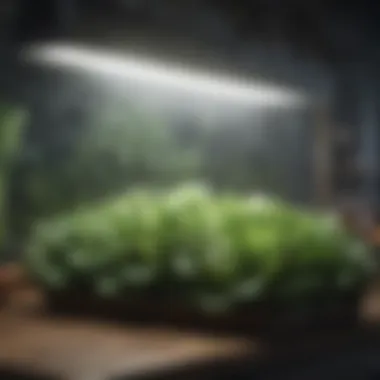
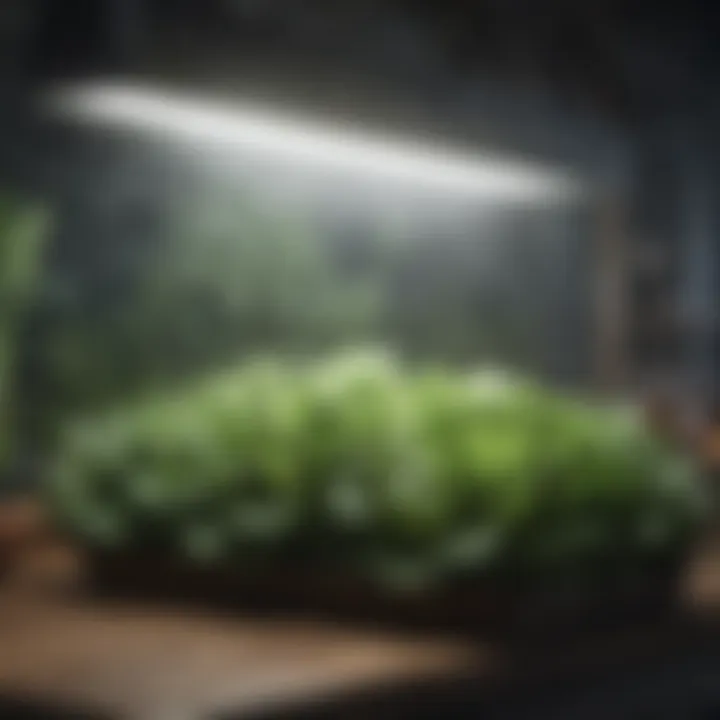
Watering is one of the most vital aspects of caring for iceberg lettuce. It affects root development, nutrient uptake, and overall plant health. Given that iceberg lettuce has shallow roots, consistent moisture is essential. However, overwatering can lead to root rot and other similar issues.
Here are a few guidelines to follow:
- Water Schedule: Water your lettuce every few days, but check the soil moisture before doing so.
- Soil Check: The top inch of soil should feel slightly dry before the next watering. This ensures the roots are taking up moisture without becoming waterlogged.
- Time of Day: Water in the morning to allow excess moisture to evaporate during the day, reducing the risk of disease.
Consider using high-quality potting soil that retains moisture effectively but also drains well.
Fertilization Practices
Fertilization plays a significant role in the health of indoor lettuce. Iceberg lettuce requires a balanced supply of nutrients to thrive. It is advisable to use organic fertilizers, as they tend to release nutrients slowly, reducing the risk of over-fertilization.
- Types of Fertilizers: Both liquid fertilizers and granular options are effective. Liquid varieties can be applied every couple of weeks, whereas granular types can be used according to package instructions.
- Nutrient Ratios: Look for fertilizers with higher nitrogen content. A ratio like 10-10-10 is generally beneficial for lettuce growth.
- Application Timing: Fertilize after planting and then continue every 3-4 weeks for optimal growth.
Note that proper fertilization promotes healthy, vibrant foliage, which is essential for iceberg lettuce.
Pest and Disease Management
Managing pests and diseases is another critical component of indoor gardening. Indoor environments can still attract unwanted pests, which can damage plants if not controlled.
Here are some approaches to handle potential problems:
- Regular Inspections: Check plants weekly for any signs of pests, such as aphids or snails.
- Natural Remedies: Consider using insecticidal soap or neem oil to manage minor infestations. These remedies are safer for indoor plants and help avoid harmful chemicals.
- Disease Prevention: To prevent diseases such as powdery mildew, ensure adequate airflow around plants. Avoid wetting the leaves while watering.
"Proactive management of pests and diseases is key to a fruitful harvest. Regular monitoring can save the crop from extensive damage."
Harvesting Iceberg Lettuce
Harvesting iceberg lettuce is a crucial step in the indoor gardening process. Understanding when and how to harvest can significantly influence the quality and taste of the produce. Incorrect timing or improper harvesting techniques can lead to damage, making the lettuce less appealing and edible. Successful indoor gardening does not just involve growing the lettuce; it also demands careful attention to the harvesting stage to optimize yield and flavor.
Timing of Harvest
Timing is essential when it comes to harvesting iceberg lettuce. The right moment for harvest can vary depending on growing conditions and specific seed variety. Generally, iceberg lettuce is ready to be harvested about 70 to 80 days after planting.
A clear indicator that your iceberg lettuce is ready for harvest is the size of the heads. Ideally, they should be firm and fully developed. Visually, you want to see tightly packed leaves, and if they are feeling dense, it’s a good sign. Another clue is the color; the leaves should be bright green without any yellowing, indicating that the plant is healthy and ready for harvesting.
Remember that lettuce continues to grow after you start harvesting. Pushing the limits of maturity can lead to a bitter taste and undesirable texture.
Techniques for Harvesting
Once you have determined that your iceberg lettuce is ready for collection, it is crucial to use the proper techniques to avoid damage. Here are some methods to consider:
- Cutting Method: Use a sharp knife or garden scissors to cut the head of lettuce at the base, just above the soil level. This method minimizes damage to the plant, and you can often obtain multiple harvests from the same plant if done correctly.
- Twisting Method: Some gardeners prefer to gently twist the head of lettuce to separate it from the roots. Make sure to do this carefully to avoid bruising the leaves.
- Pulling Method: This technique is less recommended for iceberg lettuce as it may lead to damage. However, if you have a loose soil structure, you can try pulling the head gently from the soil. Be cautious not to pull the entire plant out of the pot.
After harvesting, it is important to handle the lettuce carefully. Bruised leaves can spoil quickly, reducing the shelf life of your crisp produce. Post-harvest care is as critical as the actual harvesting process, as it directly affects storage, usage, and overall satisfaction in the final product.
In summary, harvesting effectively not only enhances the experience of indoor gardening but also ensures that you enjoy flavorful, healthy iceberg lettuce as part of your diet.
Post-Harvest Handling
Post-harvest handling is a critical phase in the cultivation of iceberg lettuce indoors. This segment deals with the actions that follow the harvest, emphasizing how these can significantly impact the quality and longevity of the produce. Proper handling ensures that the efforts put into growing are rewarded with fresh and crisp lettuce that retains its nutritional value.
Storing Iceberg Lettuce
Storing iceberg lettuce correctly is essential for maintaining its freshness and crunchiness. After harvesting, wash the lettuce gently to remove any dirt or debris, and pat it dry with a soft towel. The next steps involve storage techniques that prevent wilting and degradation.
Place the washed lettuce in a breathable container, such as a perforated plastic bag or a container with ventilation. It is advised to store it in the crisper drawer of the refrigerator, where humidity levels are higher. This environment helps to control moisture loss, preserving the lettuce's texture.
- Avoid storing iceberg lettuce with fruits like apples or bananas. These fruits emit ethylene gas, which can hasten spoilage.
- Check the lettuce regularly for any signs of spoilage. Remove any damaged leaves promptly to prevent them from affecting the rest of the harvest.
Using Fresh Harvests
Utilizing fresh iceberg lettuce immediately after harvest is one of the best ways to enjoy its crispiness and flavor. It is recommended to use it in salads, sandwiches, or as a garnish for various dishes. Fresh lettuce not only enhances the taste of meals but also provides numerous health benefits.
Moreover, fresh iceberg lettuce can be easily incorporated into various dietary preferences, making it a versatile ingredient. Here are some practical tips:

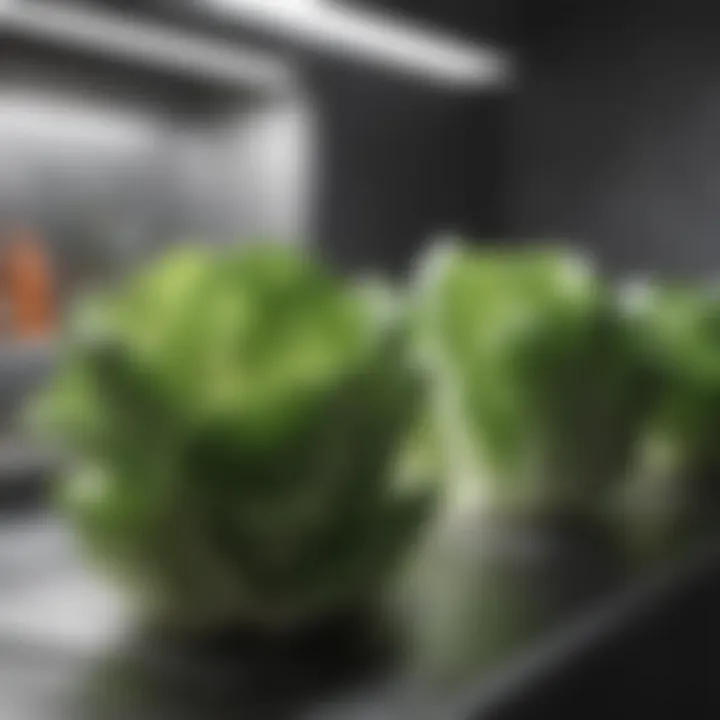
- Salads: Combine it with other greens, vegetables, and proteins for a nutritious salad.
- Wraps: Use leaves of iceberg lettuce as a wrap for fillings like grilled chicken or vegetables for a low-carb option.
Fresh iceberg lettuce is more than just a side; it's an integral part of a healthy diet, rich in vitamins and minerals.
With proper post-harvest handling, both storage and immediate usage, you can maximize the benefits of your indoor gardening efforts.
Common Challenges in Indoor Lettuce Growing
Growing iceberg lettuce indoors can lead to numerous benefits, but it is not without its challenges. Understanding these challenges is crucial for anyone who wants to succeed in cultivating this leafy green. Indoor gardening presents a controlled environment, yet it can also be susceptible to factors that may compromise plant health. By recognizing these common issues, gardeners can implement effective strategies to mitigate them, ensuring a more fruitful indoor growing experience.
Light Deficiency Issues
Adequate lighting is fundamental for healthy plant growth. Iceberg lettuce, like many leafy greens, requires a minimum of 12-16 hours of light daily. Insufficient light can lead to weak plants, elongated stems, and poor leaf development. This not only affects the visual appeal of the plants but can also reduce their nutritional quality.
Gardeners should consider using full-spectrum LED grow lights. These lights simulate natural sunlight and encourage robust growth. Placing the lights as close as possible, typically within 6-12 inches above the plants, can optimize light absorption. It is essential to monitor the plants regularly, moving lights closer or further away based on growth patterns and leaf color. Using a light timer can help maintain a consistent light schedule, reducing human error in lighting management.
Strategies to combat light deficiency include:
- Rotating plant position regularly to ensure even light exposure.
- Utilizing reflective materials around plants to maximize light usage.
- Monitoring plant health for signs of stretching, which indicates inadequate light.
Overwatering Problems
Overwatering is a frequent challenge for novice gardeners. Iceberg lettuce thrives in consistently moist soil but does not tolerate soggy conditions. Excess water can lead to root rot, a condition that severely damages or kills the plant. Recognizing the signs of overwatering, such as yellowing leaves or a mushy stem, is crucial for timely intervention.
To prevent overwatering, gardeners should adjust the watering frequency based on environmental conditions. Using pots with drainage holes is essential. This allows excess water to escape and prevents the soil from becoming waterlogged. Proper soil selection is also important; opting for a mix designed for lettuce or leafy greens can enhance drainage and aeration.
Tips to manage watering effectively include:
- Checking soil moisture before watering. The top inch should feel dry.
- Watering in the morning to reduce evaporation and fungal issues.
- Learning to read plant signals. Curling leaves may indicate thirst, while droopy leaves can signify overuse of water.
"Understanding the challenges in indoor gardening, particularly with iceberg lettuce, provides the foundation for a successful and fulfilling growing experience."
Sustainable Practices in Indoor Gardening
Indoor gardening presents a unique opportunity to adopt sustainable practices, an aspect that becomes increasingly important in today’s environmental discussions. Focusing on sustainability while growing iceberg lettuce indoors does not just impact the immediate gardening experience; it also contributes to a larger movement towards eco-friendliness. This section will address key elements such as resource conservation, use of eco-friendly materials, and the potential benefits of these methods.
By implementing sustainable practices, gardeners can significantly reduce their environmental footprint. The benefits include less waste, reduced water usage, and improved soil health. For indoor gardeners, focusing on sustainability encourages awareness about resource consumption and promotes responsible gardening methods.
Water Conservation Techniques
Water conservation is crucial in indoor gardening, as it directly influences the success of your lettuce cultivation. Here are some effective techniques:
- Drip irrigation systems: This method ensures that water goes directly to the roots, minimizing waste and evaporation.
- Utilizing rainwater: Collecting rainwater in barrels is an excellent way to harness a natural resource. It can be used to fill watering cans or connect to an irrigation system.
- Moisture sensors: Installing moisture sensors can help determine when the soil is truly dry, preventing overwatering and ensuring efficient water use.
- Mulching: Though less common indoors, using mulch can help retain moisture in the soil and reduce the frequency of watering.
Using water responsibly not only supports the plants' needs but also aligns with broader sustainability goals.
Organic Fertilizers
Organic fertilizers play a vital role in maintaining sustainable indoor gardening. They promote soil health without the negatives associated with synthetic options. Here are some aspects to consider:
- Nutrient-rich options: Organic fertilizers such as compost, worm castings, and fish emulsion provide essential nutrients to iceberg lettuce while enhancing soil structure.
- Reduced chemical runoff: Using organic methods limits the potential for chemicals to leach into waterways, which is a common concern with synthetic fertilizers.
- Enhancing biodiversity: By nurturing the soil ecosystem, organic fertilizers help, thus supporting beneficial microorganisms which can lead to a healthier garden.
- Home-made fertilizers: Gardeners can create their own organic fertilizers from kitchen scraps, such as banana peels or coffee grounds, further reducing waste.
Incorporating organic fertilizers not only benefits the plants but also contributes positively to the environment, making it a critical choice for any indoor gardener.
"The effort to grow sustainably can yield a bountiful harvest while also benefiting our planet."
Through the adoption of sustainable practices in indoor gardening, particularly with techniques in water conservation and the use of organic fertilizers, growers can enjoy fresh iceberg lettuce while knowing they are participating in a responsible and eco-friendly horticultural approach.
Closure
In concluding this comprehensive guide on indoor growing of iceberg lettuce, it is crucial to reflect on the key elements that make this endeavor not only beneficial but also achievable. Growing iceberg lettuce indoors offers several advantages, including year-round access to fresh produce, better control over growing conditions, and the opportunity to engage in a fulfilling hobby.
Final Thoughts on Indoor Iceberg Lettuce Cultivation
Cultivating iceberg lettuce indoors can be a rewarding venture. The process involves careful consideration of factors such as lighting, temperature, and watering routines.
- Adequate Lighting: Ensuring your lettuce receives sufficient light is essential for healthy growth. Utilizing LED grow lights mimics natural sunlight and can significantly increase your yield.
- Temperature Management: Iceberg lettuce thrives in cooler conditions. Maintaining an ideal range of 60 to 70 degrees Fahrenheit promotes optimal growth and prevents bolting.
- Consistent Watering: Regular but moderate watering is vital. Overwatering can lead to root rot while under-watering can stunt growth.
- Nutrient-Rich Soil: Selecting the right potting mix enhances root development and ensures your plants receive necessary nutrients.
By addressing these core elements, homeowners, gardening enthusiasts, and anyone interested in sustainable practices can enjoy the fruits of their labor.
Growing iceberg lettuce indoors is not just a farming practice; it is a lifestyle choice that enhances indoor living environments. With careful management and dedication, the effort can lead to crisp, fresh lettuce that brightens up any meal. Ensuring ongoing education and adaptation to one’s specific indoor conditions can further increase success rates in future cultivation endeavors.















